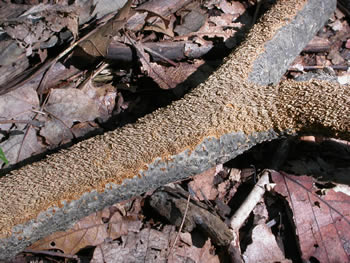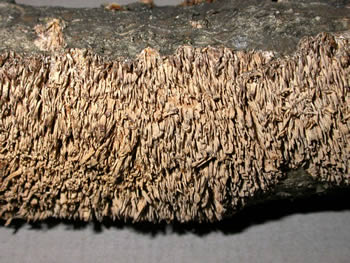Hydnoporia olivacea
Scientific name: Hydnoporia olivacea (Schwein.)
Teixeira
Derivation of name: Olivace- means "olive-colored" in
reference to a common coloration of this fungus.
Synonyms: Irpex cinnamomeus Fr.; Hydnochaete
olivacea (Schwein.) Banker; Pseudochaete olivacea
(Schwein.) Parmasto
Common name(s): Brown-toothed crust.
Phylum: Basidiomycota
Order: Hymenochaetales
Family: Hymenochaetaceae
Occurrence on wood substrate: Saprobic; spreading,
crustlike on decaying deciduous tree branches; June
through October, year-round.
Dimensions: Spreading fruit body may be 5-10 cm (or
more) wide and 10-20 cm (or more) long.
Description: Fruit bodies are olive-brown to reddish-
brown, leathery or stiff, spreading crusts with a jagged,
toothlike surface. The flat teeth are 3-6 mm long and are
covered with tiny reddish-brown spines (setae) 0.035-to
0.15 mm long. The setae are visible with a 15x hand lens.
Comments: The setae are found only on the teeth.

Figure 1. Hydnoporia olivacea as it often appears on
dead
branches of hardwood trees. A common substrate is
oak (Quercus).
Photo © Gary Emberger.

Figure 2. The most striking characteristic of this fungus,
at
first sight, is the jagged, toothlike surface.
Photo © Gary Emberger.

Figure 3. The teeth are flat, 3-6 mm long, and ragged near
their tips. Photo © Gary Emberger.

Figure 4. Reddish-brown conical spines (setae) cover the teeth
of Hydnoporia olivacea. The spines are tiny but visible with
a 15X or 20X hand lens. Photo © Gary Emberger.